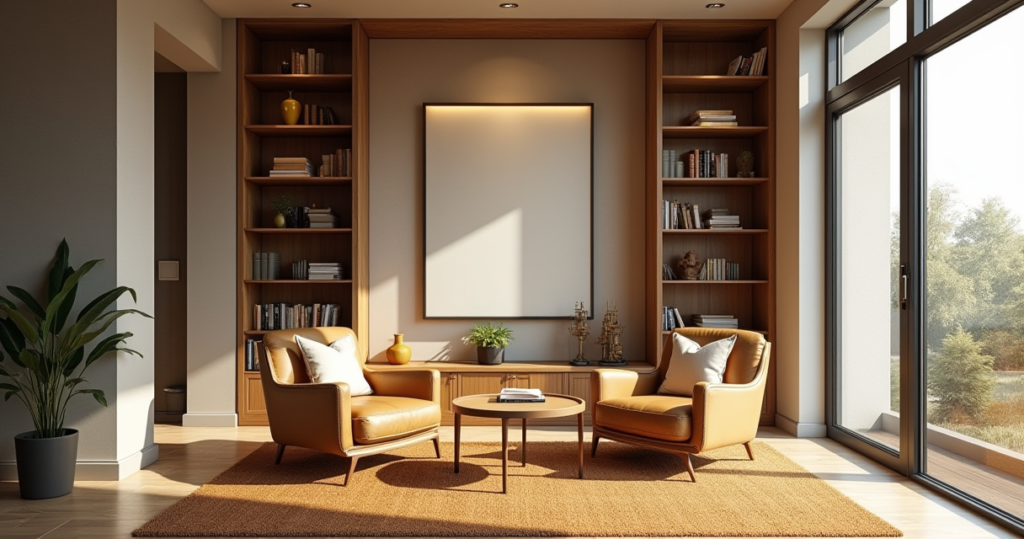You know what really gets under my skin? Can we just talk for a second about why everyone gets Indian design wrong?
People hear “Indian-inspired” and their minds either jump to a sterile, beige room with a single, sad-looking Buddha head, or they imagine an explosion in a spice market—cluttered, overwhelming, and frankly, a bit of a caricature. It drives me wild! Because the real magic, the soul of it, isn’t about throwing a few clichés at a wall. It’s about telling a story. It’s about weaving the vibrant, soul-deep richness of our heritage into a home that feels completely modern, completely balanced, and completely you.
It’s about creating a space where a sleek, contemporary sofa can live in harmony with a set of antique brass temple toys your grandmother gave you. A space that feels both serene and alive. So, forget the corporate design-speak. Let me tell you how we actually create a living room that has a heartbeat.
Foundation & Planning Your Ideal Living Space
Before you fall in love with a saffron-colored velvet sofa or a stunning piece of Madhubani art, we need to lay the groundwork. This isn’t the boring part; it’s the part where we map out your story. Think of it like stretching a canvas before you paint. Skipping this is like trying to build a beautiful haveli on sand—it’s just not going to hold up.
1. Define Your Living Room’s Primary Function Clearly
First things first: who is this room for? I don’t mean in a general sense. I mean, what is its true purpose, its dharma? Is this a space for sprawling out with the kids for a Bollywood movie night, with bowls of popcorn everywhere? Or is it your quiet sanctuary, where you’ll curl up with a cup of chai and a book? Perhaps it’s the heart of your hospitality, where you’ll host lively Diwali parties and friends will gather on the floor, sharing stories until late.
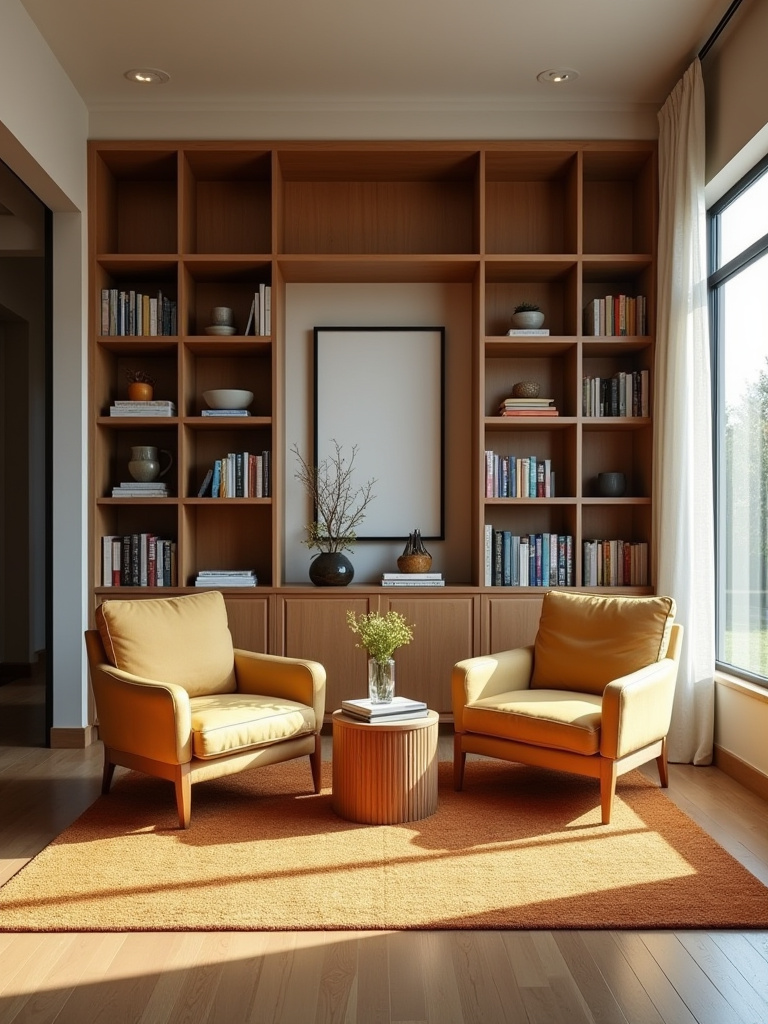
Don’t just think about how you use it now, but how you dream of using it. I once had a client, a young family in a slick city apartment, who felt their living room was cold and unused. We didn’t start with furniture; we started with feelings. They wanted “the warmth of a Sunday afternoon at Nani’s house.” That became our guide. The function wasn’t just ‘watching TV’; it was ‘creating connection’. And suddenly, every choice had a purpose.
Now, with that feeling in mind, let’s talk about the visual language your room will speak.
2. Establish a Cohesive Design Style for Unified Interiors
“Cohesive style” sounds so rigid, doesn’t it? Banish that thought. This is not about picking a label like “Bohemian” or “Mid-Century Modern” from a catalog. It’s about creating your own unique fusion. Think of yourself as a master chef, blending spices. A pinch of Scandinavian clean lines, a generous handful of Rajasthani color, a whisper of coastal calm—it can all work together if you find the common thread. The key is to tell one story, not a dozen shouting over each other.

A client of mine was obsessed with the serene, wabi-sabi vibe of Japanese design but also wanted to honor her Keralan roots. “Jaipur-meets-Japandi” became our mantra. We chose a palette of muted greens, charcoal, and warm woods, then brought in the soul with a single, stunning Kathakali-inspired artwork and cushions made from vintage silk saris in those same tones. The result was a room that felt both profoundly peaceful and deeply personal. It had one clear, beautiful voice.
Next up, we get practical. Let’s make sure that beautiful vision actually fits.
3. Measure Your Room Accurately for Perfect Furniture Scale
This may sound tedious, but trust me, it’s a sacred ritual. There is nothing more heartbreaking than finding the perfect antique Indian chest to use as a coffee table, only to get it home and realize it swallows the entire room, or worse, won’t even fit through the door. I’ve seen it happen. Measure everything: the walls, the windows, the doorways, and yes, the tight corners in your hallway.
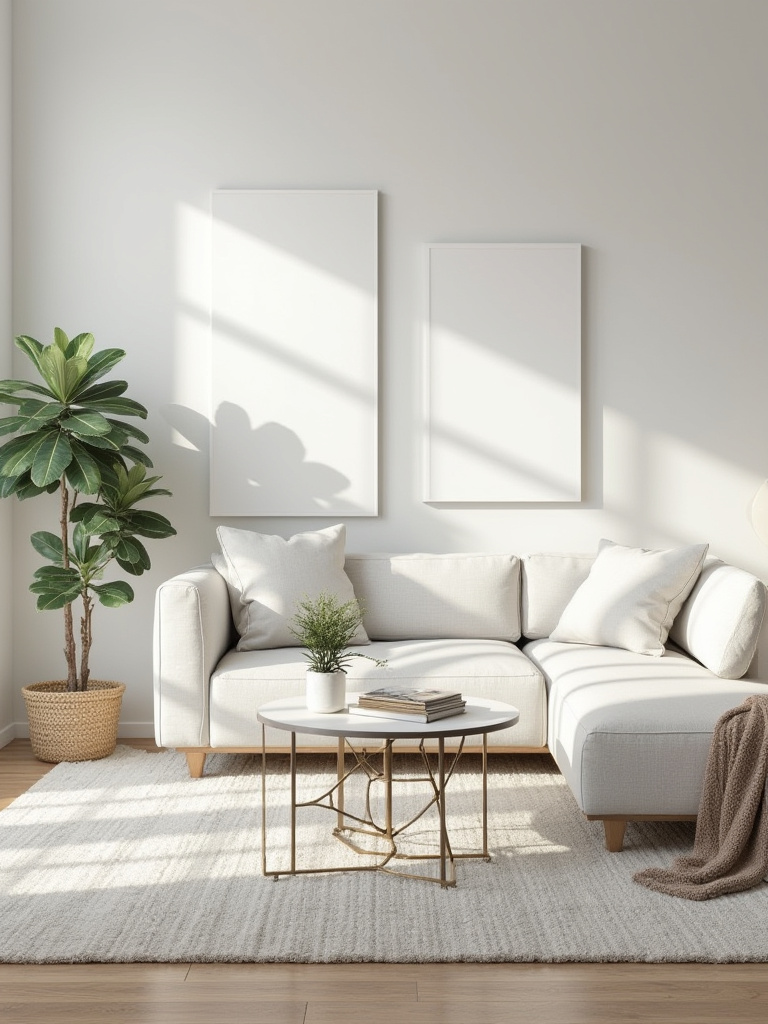
Here’s a shortcut I swear by, and it costs next to nothing. Once you have the dimensions of a sofa or a cabinet you love, use painter’s tape to outline its exact footprint on your floor. Live with it for a day. Walk around it. Does it block the path to the balcony? Does it feel like a giant elephant in a teacup? This little trick has saved my clients (and myself!) from so many expensive, soul-crushing mistakes.
Once you know what fits, you need to decide how to move around it.
4. Plan Clear Traffic Pathways for Smooth Movement
A living room should feel like a graceful dance, not an obstacle course. You need to be able to move with ease and grace. In traditional Indian architecture, there’s always a beautiful sense of flow—from a verandah into a central courtyard, for instance. We want to create that same feeling of effortless movement, where energy can flow freely.
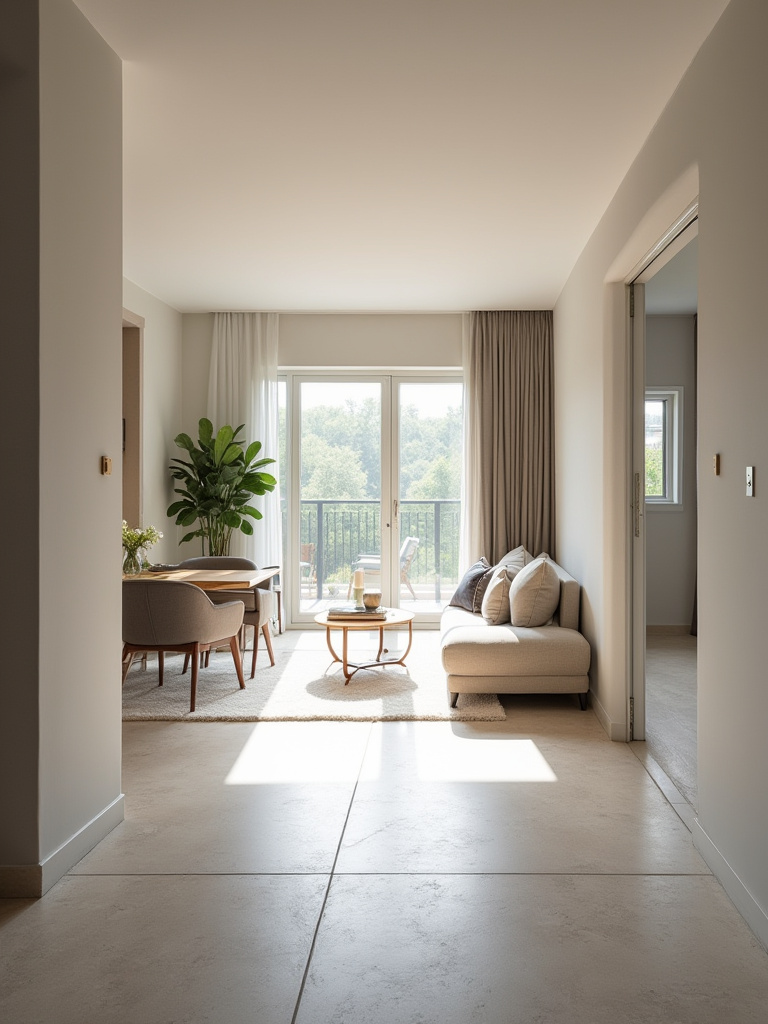
Make sure your main walkways—the path from the door to the sofa, for instance—are at least three feet wide. You shouldn’t have to turn sideways to squeeze past the coffee table. I always imagine carrying a tray of chai and glasses. If you can’t navigate that without spilling, your pathways are too narrow. It’s a simple test, but it guarantees your room will feel generous and welcoming, not cramped and frustrating.
Now, let’s gather all these foundational ideas into one beautiful vision.
5. Curate a Digital Mood Board for Visual Cohesion
Forget spreadsheets; I want you to create a treasure map. A mood board isn’t just a collection of sofas and lamps you like. It’s a collage of the feeling you want to create. Pin that image of a weathered blue door from a Jodhpur alley. Add a close-up shot of the gold zardozi embroidery on a beloved shawl. Pin the exact shade of marigold yellow that makes your heart sing.
This becomes your visual compass. Before you buy anything—a pillow, a pot, a painting—hold it up to your treasure map. Does it belong? Does it add to the story or distract from it? I once had a client who was about to buy a very trendy, gray sofa. But we looked at her mood board, filled with the warmth of terracotta, sandalwood, and hand-spun cottons. The gray sofa felt like a sudden raincloud. We found a gorgeous couch in a warm, earthy tone instead, and it snapped the whole room into focus.
Strategic Furniture Selection & Layout Principles
Alright, our canvas is prepped! Now for the main event: bringing in the beautiful, functional pieces that will form the heart of your room. This is where we anchor your story and make space for life to unfold.
6. Anchor Your Room Layout with a Strong Focal Point
Every great story has a hero, and every great room has a focal point. It’s the first thing your eye is drawn to, the star of the show. And it doesn’t have to be a fireplace! Think bigger, more personally. What about a massive, ornate jharokha—a traditional Rajasthani window frame—hung on the wall as a mirror? Or a spectacular Kalamkari or Pichwai painting depicting ancient tales?
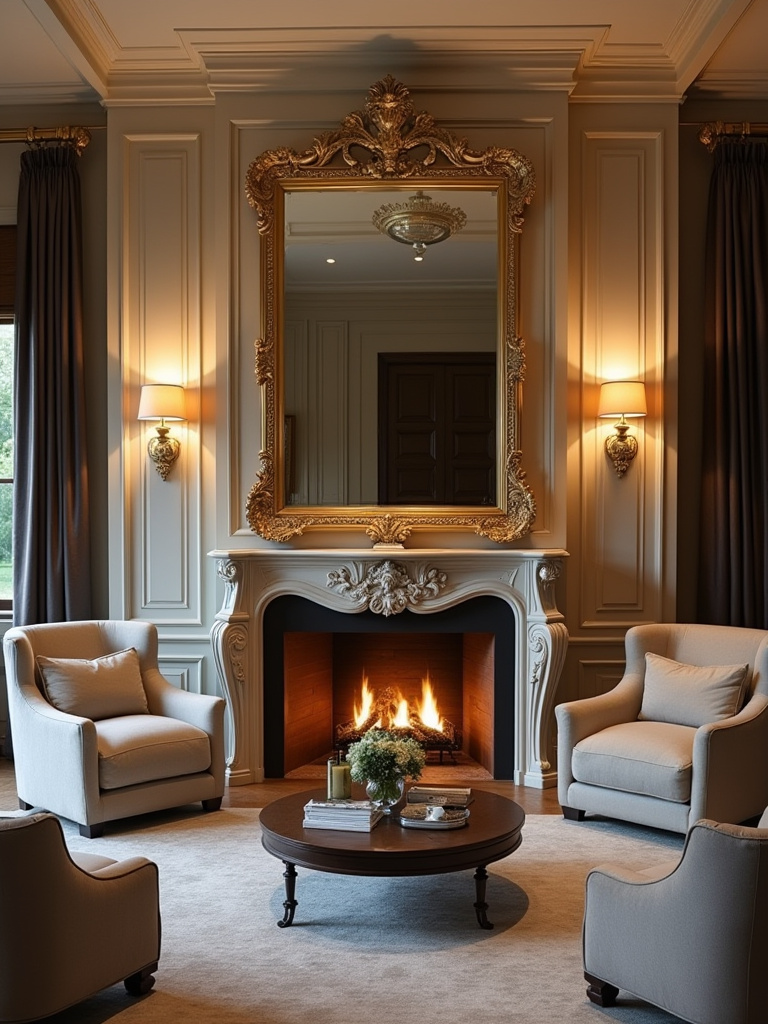
One of my favorite projects used a custom-made jhoola, a stunning carved wooden swing, as the focal point. It was suspended in front of the main window. It was playful, elegant, and so deeply rooted in culture. We arranged the sofas and chairs to face it, making it the undeniable heart of the home. Find your hero piece—the one that makes you gasp—and let everything else play a supporting role.
Now that we have our star, let’s arrange the seating for an audience.
7. Arrange Seating to Encourage Effortless Conversation Flow
A living room is for living, and so much of life is about connection. We want to create a space that invites conversation, that pulls people in. The goal is to create a welcoming circle, a modern-day baithak, where stories and laughter can be shared easily. Don’t just shove a sofa against one wall and chairs against the other, creating a vast no-man’s-land in between.

Pull your seating away from the walls and group it together. A good rule of thumb is that people should be close enough to hear each other without shouting, but not so close they’re knocking knees—usually about 4 to 8 feet apart. Here’s a trick I adore: use at least one swivel chair. It’s the ultimate connector. It allows someone to easily turn from the main conversation to a more private chat with the person next to them, or to pivot towards the window and enjoy the view.
As you plan your seating, think about how each piece can work harder for you.
8. Select Multi-functional Furniture for Smart Space Utilization
Especially in modern homes where space is a luxury, every piece should earn its keep. This is a concept deeply familiar in India, where a single space often serves many purposes throughout the day. A beautiful carved chest (sandook) isn’t just a nostalgic object; it’s a stunning coffee table with a world of hidden storage for blankets and board games.
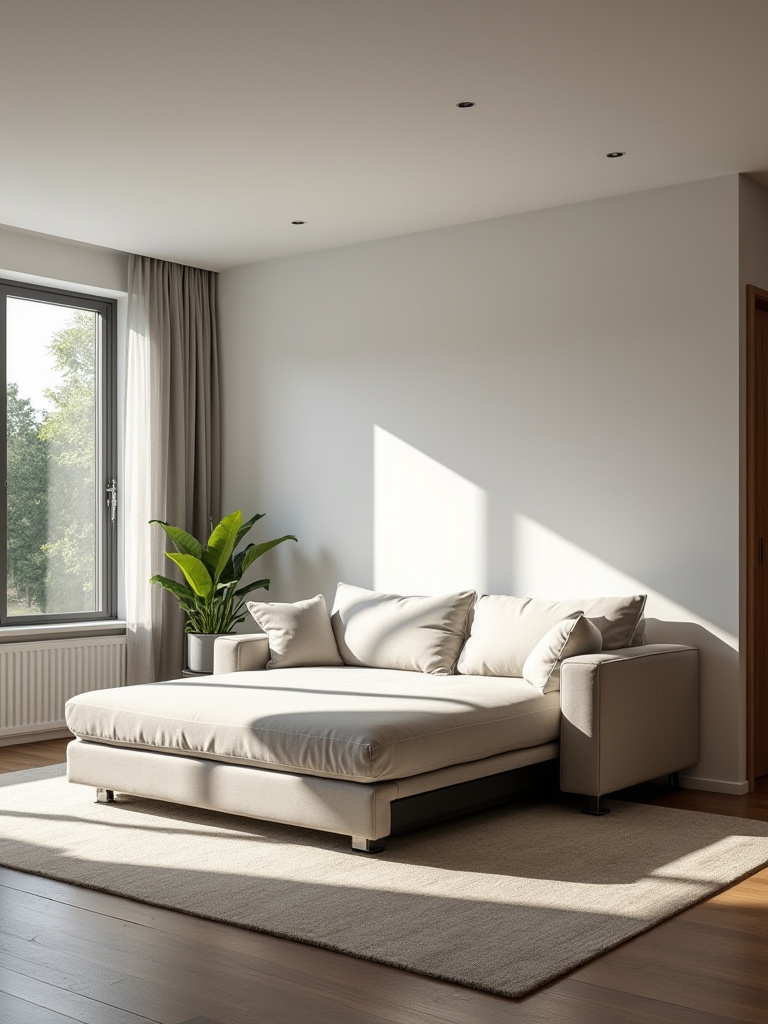
Look for pieces with secret identities. A beautiful wooden diwan or daybed can be a chic sofa by day and, piled with plush bolsters, a comfortable spot for an overnight guest. Ottomans that open up for storage, or nesting tables that can be spread out for guests and tucked away for daily life—these are your best friends. It’s the art of creating abundance in your space, no matter the square footage.
With your furniture in place, let’s ground it all with a touch of magic.
9. Choose the Optimal Rug Size to Define Distinct Areas
Please, I beg you, do not fall for the tiny “postage stamp” rug! A rug that’s too small makes a room feel stingy and all your furniture look like it’s drifting away at sea. A rug is not just a rug; it’s a magic carpet. It’s the anchor that gathers all your pieces together and creates a unified, intentional space, like a courtyard within a home.
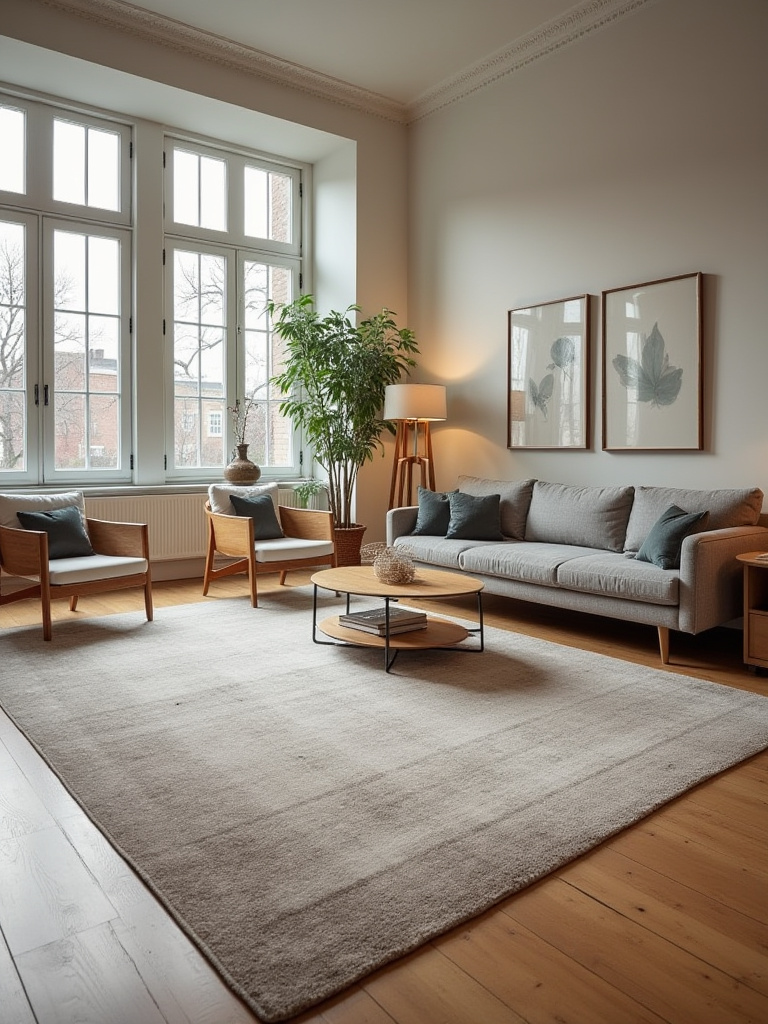
The golden rule is that at least the front legs of all your main seating pieces should be sitting comfortably on the rug. This pulls everything into a cozy, conversational grouping. Think about a hand-knotted dhurrie or a vibrant kilim with patterns that tell a story. In a large, open-plan space, a generous rug can instantly create an intimate ‘room within a room’, signaling that this is the spot where you come together to relax.
And speaking of relaxing, let’s make sure our beautiful furniture can withstand it.
10. Prioritize Durable Fabrics for High-Traffic Upholstered Pieces
You should never have to sacrifice beauty for practicality. Gone are the days when a ‘durable’ fabric meant something stiff and scratchy. With today’s technology, you can have a sofa that looks and feels like sumptuous raw silk or hand-spun khadi but repels stains like magic. It’s about being smart, so you can actually live in your living room without constantly worrying about spills and smudges.
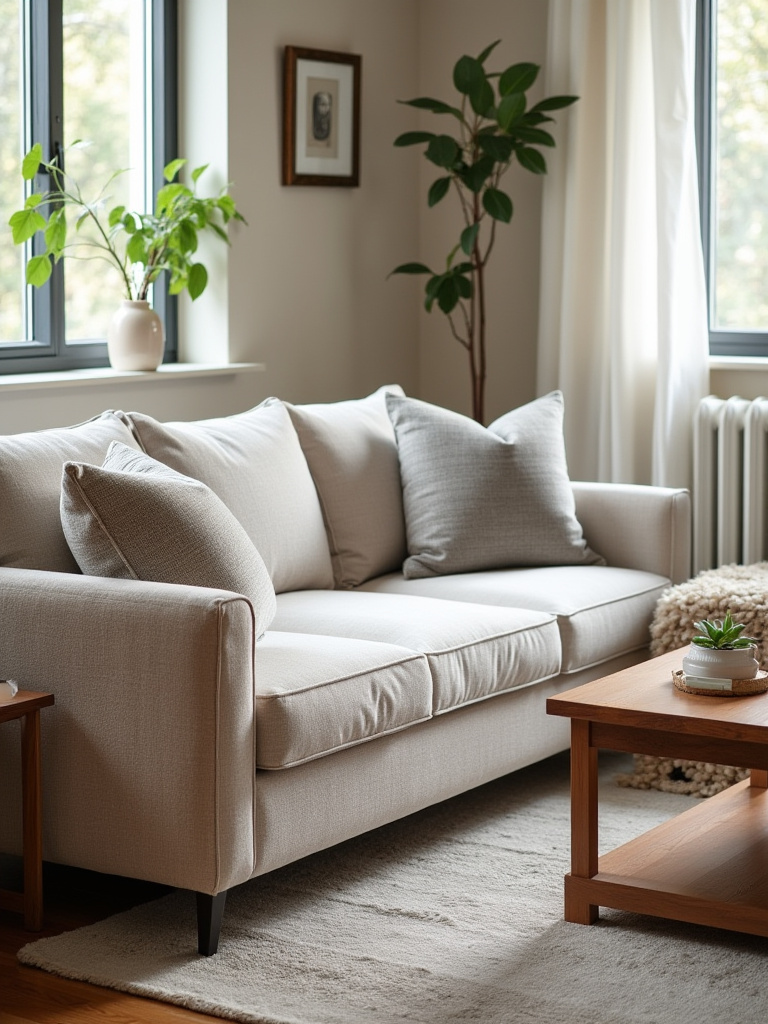
I had a client with two small children and a golden retriever who desperately wanted a pale, cream-colored sofa to keep their space light and airy. Everyone thought she was crazy. We found an incredible performance fabric that looked just like a luxurious linen-cotton blend. A few months later, she sent me a video of her son’s chocolate handprint wiping away with just a damp cloth. That’s not just a durable fabric; that’s freedom.
Elevating Ambiance Through Light and Color
Now that the bones of the room are in place, it’s time to breathe life into it. Light and color are the soul of a space. They set the mood, tell the emotional story, and turn a well-arranged room into an enchanting sanctuary.
11. Implement layered lighting for Flexible Mood Setting
One single, harsh overhead light is a design tragedy. It flattens everything and makes a room feel like a waiting room. To create warmth and intimacy, you need to think in layers, just like a beautifully adorned sari. You need a mix of ambient, task, and accent lighting that you can play with to match any mood.
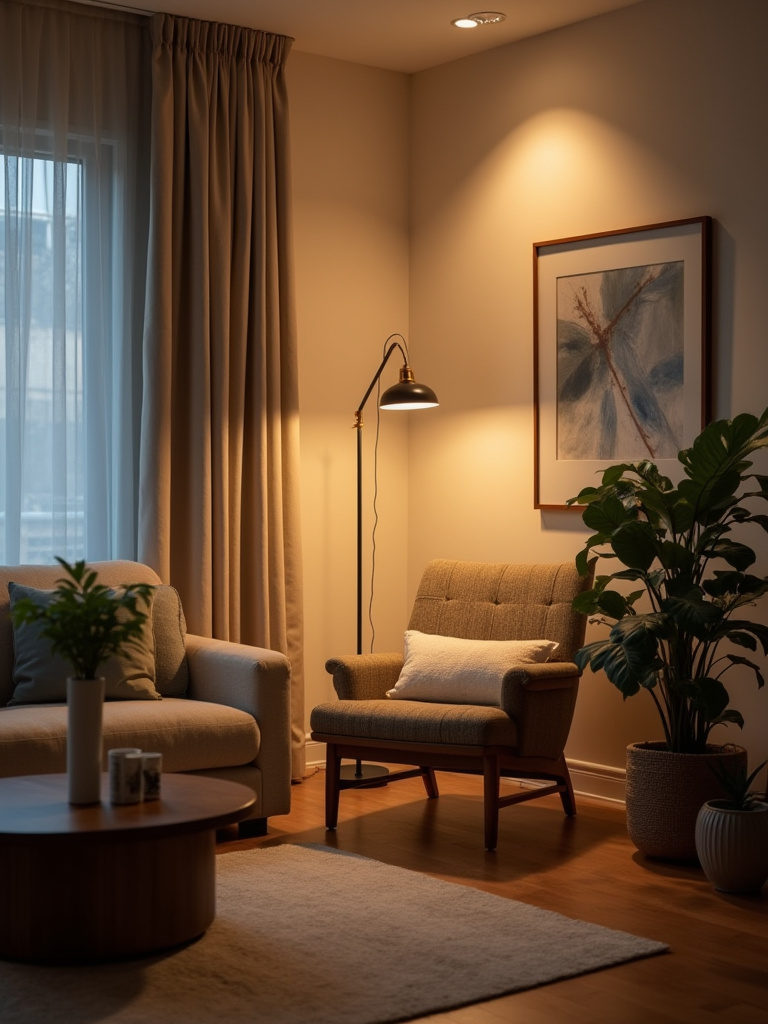
Start with your general (ambient) light, but make sure it’s on a dimmer. Then, add task lighting: a beautiful floor lamp with a silk shade for reading, or table lamps on either side of the sofa. Finally, the magic layer: accent lighting. Think ornate brass lamps that cast a warm glow, or a cluster of hanging kandil lanterns in a corner. You want to create soft pools of light that invite you in, creating a space that can be bright and festive for a party, or soft and dreamy for a quiet evening.
While we’re talking about light, let’s not forget its most important source.
12. Optimize Natural Light with Thoughtful Window Treatments
Natural light is a blessing—we should celebrate it, not block it out with heavy, lifeless drapes. The key is to manage it, to play with it. Think about the way light filters through the intricate stone latticework of a jaali screen, creating dancing patterns on the floor. We can recreate that feeling with our window treatments.
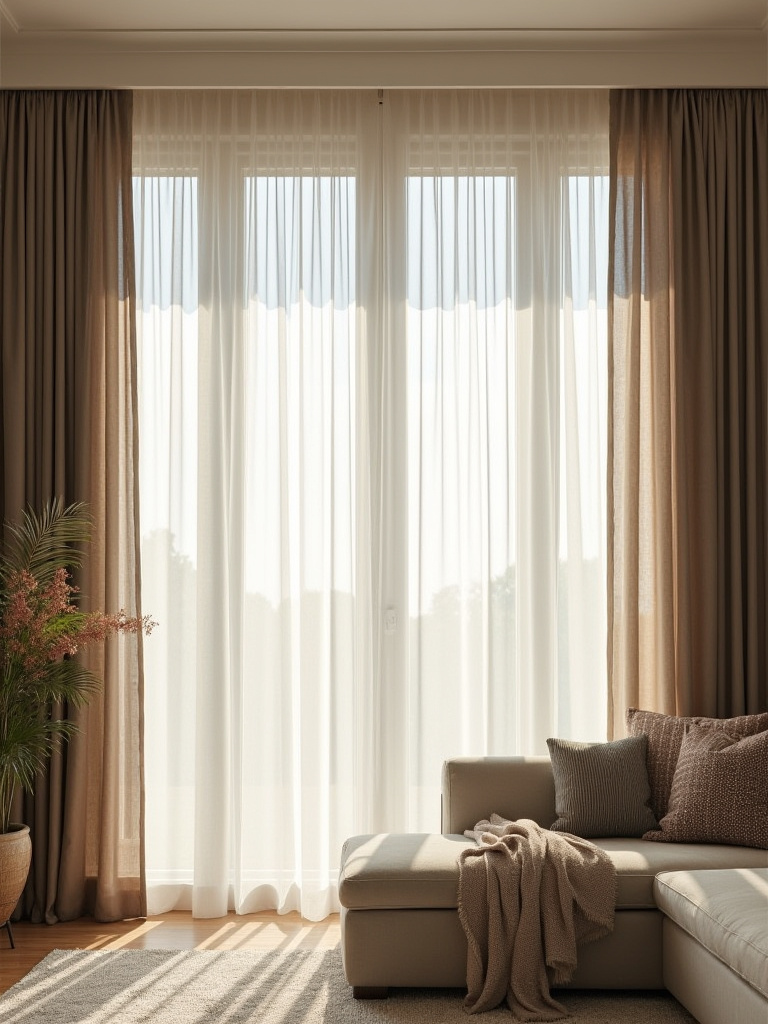
Sheer, hand-block-printed voiles or delicate chikankari curtains are perfect for this. They offer privacy while allowing a soft, diffused light to pour into the room, bathing it in a gentle glow. You can layer them with heavier drapes that can be drawn at night for coziness. This way, you’re not just covering a window; you’re curating the light itself, making it another beautiful, textural element in your room.
And what that light falls upon is just as important.
13. Craft a Cohesive Color Palette for Visual Harmony
Color is emotion. In India, we understand this instinctively. Saffron isn’t just orange; it’s auspiciousness and energy. Indigo isn’t just blue; it’s depth and royalty. Don’t be afraid of bold, rich, jewel-like tones. The secret to using them in a contemporary space is balance. Follow the 60-30-10 rule: 60% of your room should be a dominant, often neutral color (think walls, a large sofa); 30% a secondary color; and 10% a vibrant accent.

Your inspiration can come from anywhere: a favorite painting, a vintage silk sari, or the complex spices in your masala box. Imagine a room with walls the color of warm sandalwood (60%), a deep indigo blue rug (30%), and brilliant pops of marigold yellow and fuchsia in the cushions and art (10%). It’s a palette that feels both exhilarating and perfectly balanced, alive with personality.
Now, let’s use light to make those colors and your favorite objects truly sing.
14. Use Accent Lighting to Highlight Architectural Features
This is your secret weapon for creating a high-end, curated feel. Accent lighting is like a tiny spotlight that says, “Look at this beautiful thing!” Use it to highlight what you love. Focus a small, discreet light on the intricate carving of a wooden console, the metallic sheen of a bronze Nataraja statue, or the stunning texture of a raw silk wall hanging.
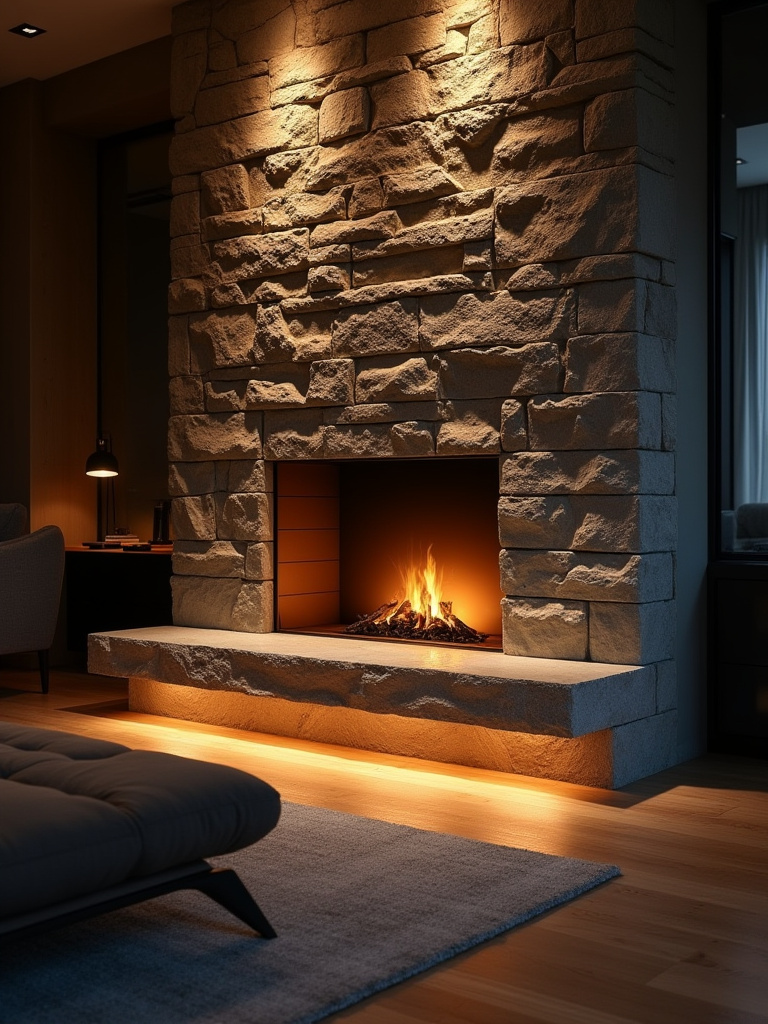
You can also use it to highlight the architecture of the room itself. If you have a lovely wall niche (gokhale), placing a tiny uplight inside it can turn it into a breathtaking feature. By selectively illuminating the special details, you create drama, depth, and sophistication. You’re guiding your guests’ eyes, telling them what parts of your story are most important.
Styling & Personalizing Your Living Room Interiors
This is the final, joyful flourish. We’ve built the stage, set the lighting, and now it’s time to bring on the players—the personal treasures and beautiful objects that make the space uniquely yours. This is where your house becomes a home.
15. Integrate Diverse Textures for Rich Visual Interest
A room without texture is a room without soul. I want you to create a feast for the senses, not just the eyes. Think about the glorious contrast of textures in an Indian market: the smooth coolness of marble, the rough weave of a jute sack, the rich pile of a velvet cushion, the nubby feel of hand-loomed cotton. Your living room should be just as sensually rich.
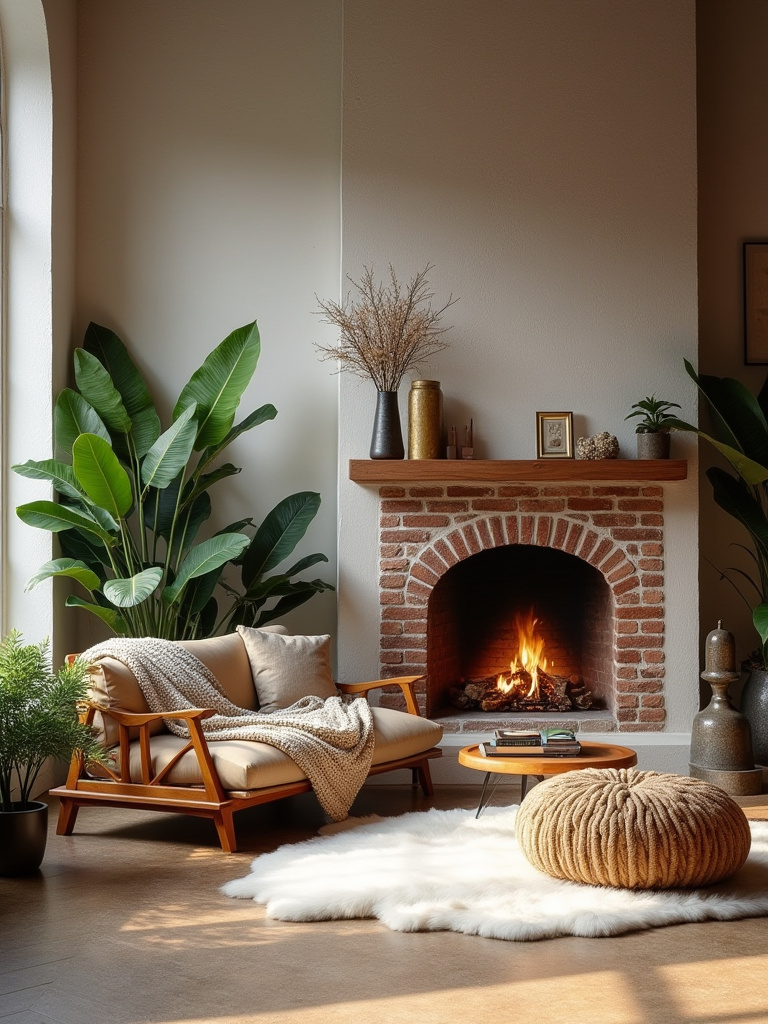
Place a soft, shaggy wool rug on a polished concrete floor. Drape a chunky-knit throw over a sleek leather armchair. Mix cushions in raw silk, block-printed cotton, and zardozi embroidery with metallic threads. It’s this layering of textures—hard with soft, rough with smooth, matte with shiny—that gives a room its depth and makes it feel incredibly luxurious and inviting. You should want to touch everything.
Now let’s shrink that idea down to your tabletops.
16. Style Coffee and Side Tables with Intentional Vignettes
Your coffee and side tables are not just drop zones for remote controls and half-empty mugs. They are little stages for storytelling. Create a beautiful vignette—a curated little collection of objects you love. Start with a foundation, like an ornate silver or brass tray, and then build on it with items of varying heights and textures.
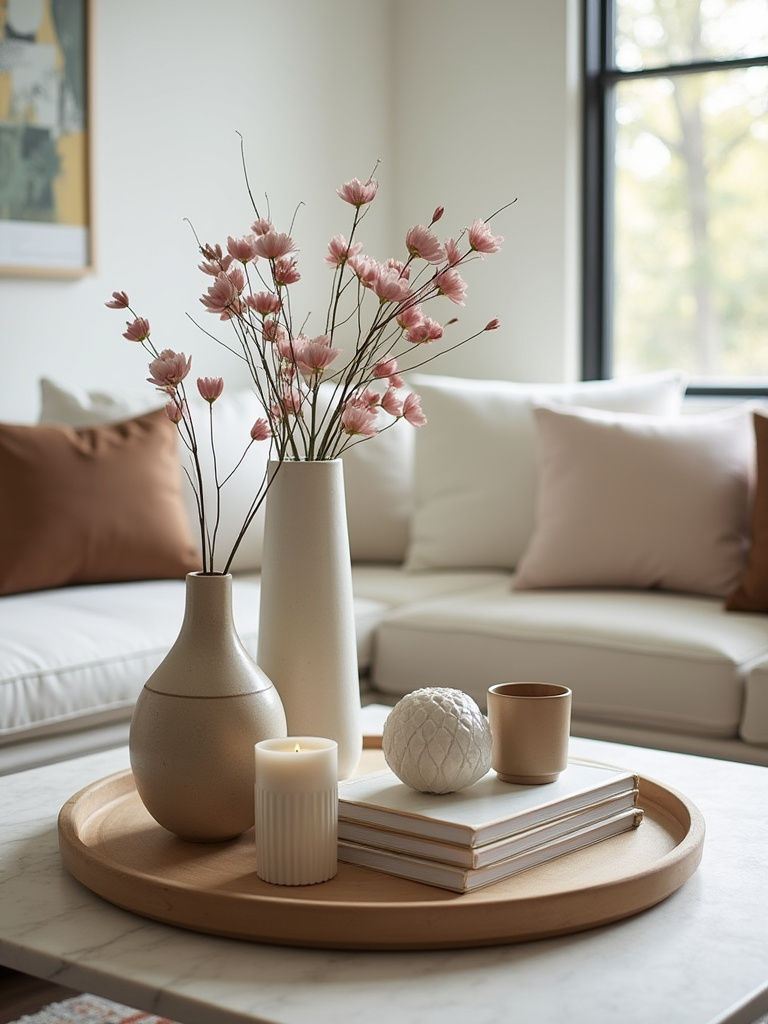
Think a small stack of beautiful art books, a scented candle in a ceramic jar, a tiny, antique brass box for storing odds and ends, and always, something living—a small vase with a single, vibrant bloom or a few fresh marigolds. This is the perfect place to display a small, meaningful souvenir from your travels or a cherished object passed down through your family. It’s a tiny, concentrated burst of your personality.
From small surfaces to big ones, let’s talk about your walls.
17. Curate Wall Art and Mirrors to Reflect Personality
Your walls are the largest canvas in your home—use them to tell your story loud and proud. This is your chance to go beyond generic, mass-produced art. Frame a beautiful piece of textile, like a square from a vintage Phulkari or Kantha quilt. Create a gallery wall of family photographs, mixing in black-and-white shots with color portraits. Hang a series of botanical prints of Indian flora.
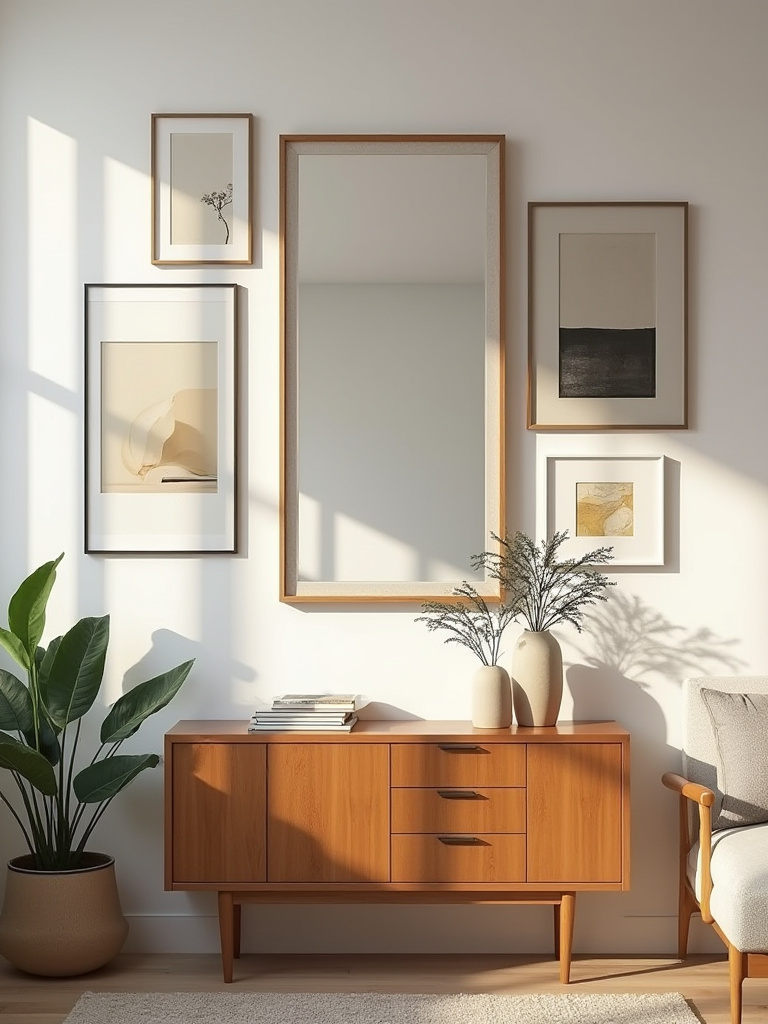
And don’t forget the power of mirrors! An ornate, oversized mirror can act as a piece of art itself, while a collection of smaller mirrors with different frames can bounce light around a room and create a sense of magic and sparkle. Every piece on your wall should mean something to you. It’s your personal museum, a gallery of your life.
Let’s bring one more living element into the story.
18. Add Greenery with Indoor Plants for Natural Vibrancy
No room is complete without the life and energy of plants. In Indian culture, plants like Tulsi and Jasmine are not just decorative; they have a sacred significance. Bringing greenery inside connects us to nature, purifies the air, and adds an effortless, organic beauty that no object can replicate.
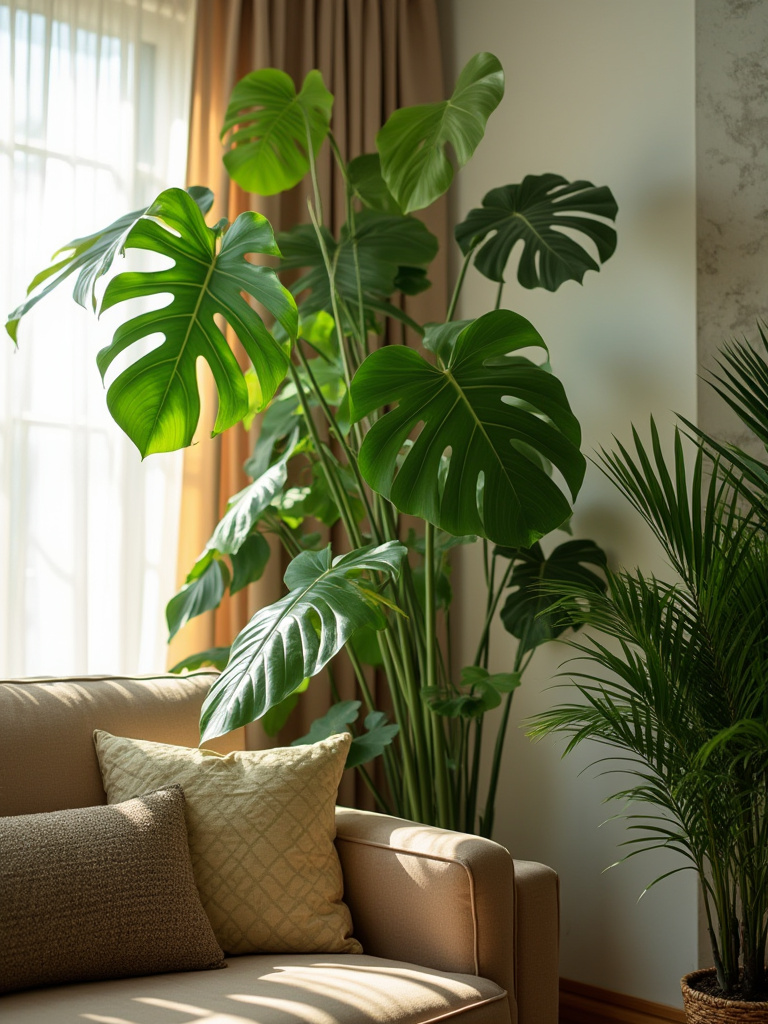
Choose plants with interesting leaf shapes and textures, like a majestic Fiddle Leaf Fig or a lush Monstera. And pay attention to their pots! Use beautiful ceramic, terracotta, or hammered brass planters that complement your decor. You can group them together in a corner to create a lush, jungle-like vignette or place a trailing plant on a high shelf to let it cascade down. They are living sculptures that grow and change with you.
Finally, the secret to making all this beauty last.
19. Maintain a Clutter-Free Space for Lasting Elegance
Now, hear me out. “Clutter-free” does not mean sterile or empty. Not at all! It means “thoughtfully curated.” It’s about giving your treasured objects room to breathe. When a room is cluttered, nothing stands out. Your beautiful things get lost in the noise. The goal is to edit, so that the things you choose to display can truly shine.
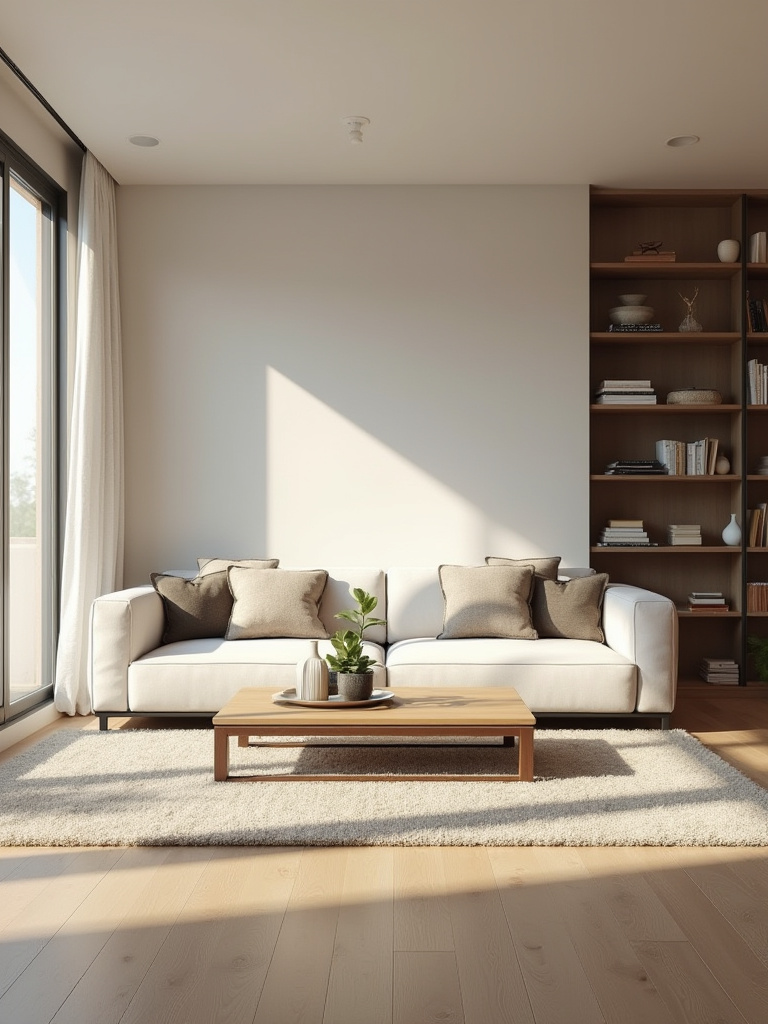
Adopt the ‘one in, one out’ rule. Find a beautiful home for everything—remotes in a lovely carved box, magazines in a woven basket, blankets in a storage ottoman. It’s a discipline, but it’s one that protects the peace and beauty of the sanctuary you’ve created. It ensures that your home tells a clear, elegant story, not a chaotic, jumbled one.
Conclusion
So you see? Mastering your living room is not about following a rigid set of rules from a magazine. It’s an art form, a beautiful, joyful process of weaving together threads of your heritage, your passions, and your modern life. It’s about creating a space that feels like a full, warm-hearted expression of you.
From laying a foundation built on your family’s story to layering in the soul-stirring magic of color, texture, and light, every step is a chance to infuse your space with personality. Don’t be afraid to be bold. Don’t be afraid to mix that sleek modern lamp with your grandmother’s antique brass. Your home is waiting to tell your story. Now you have the map to help you write it, chapter by beautiful chapter.
